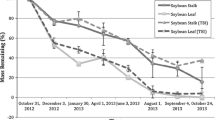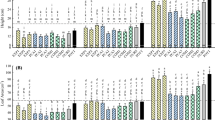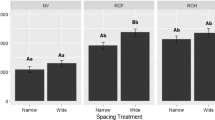Abstract
We hypothesized that tree-based intercropping in southwestern Québec, Canada, would stimulate soil microbial activity and increase soil nutrient supply, thereby benefiting the growth of trees. Our experimental design comprised alternating rows of hybrid poplar (Populus nigra L. × P. maximowiczii A. Henry) and high-value hardwood species spaced 8 m apart, between which two alley treatments were applied 5–6 years after planting the trees. The first alley treatment consisted of a fertilized soybean (Glycine max (L.) Merr.) intercrop grown over two consecutive years, while the second consisted of repeatedly harrowing to minimize vegetation in the alley. Tree rows were mulched with a 1.5 m wide polythene mulch. Microbial respiration and biomass, and mineral N concentrations and mineralization rates were measured on five or six dates at 0, 2 and 5 m from hybrid poplar rows. On some of the sampling dates, we found significantly higher soil microbial biomass, mineral N concentrations and nitrification rates, and a significantly lower microbial metabolic quotient (qCO2), in the soybean intercropping than in the harrowing treatment. Over the 2 year period, hybrid poplar biomass increment and N response efficiency (NRE) were significantly higher (51 and 47%, respectively) in the intercropping than in the harrowing treatment. Microbial biomass and mineral N supply were significantly lower beneath the polyethylene mulch than in the alleys, and we posit that this may stimulate the growth of tree roots into the alley. We conclude that soybean intercropping improves nutrient turnover and supply for hybrid poplar trees, thereby increasing the land equivalent ratio (LER).


Similar content being viewed by others
References
Agriculture Canada Expert Committee on Soil Survey (1987) The Canadian system of soil classification (CSSC), 2nd edn. Agriculture Canada, Ottawa, ON. Publication 1646:1–164
Allen SC, Jose S, Nair PKR, Brecke BJ, Nkedi-Kizza P, Ramsey CL (2004) Safety-net role of tree roots: evidence from a pecan (Carya illinoensis K. Koch)—cotton (Gossypium hirsutum L.) alley cropping system in the southern United States. For Ecol Manag 192:395–407
Allen SC, Jose S, Nair PKR, Brecke BJ, Nair VD, Graetz DA, Ramsey CL (2005) Nitrogen mineralization in a pecan (Carya illinoensis K. Koch)—cotton (Gossypium hirsutum L.) alley cropping system in the southern United States. Biol Fertil Soils 41:28–37
Anderson JPE, Domsch KH (1978) A physiological method for the quantitative measurement of microbial biomass in soils. Soil Biol Biochem 10:215–221
Anderson TH (2003) Microbial eco-physiological indicators to assess soil quality. Agric Ecosyst Environ 98:285–293
Ben Brahim M, Gavaland A, Cabanettes A (2000) Generalized allometric regression to estimate biomass of Populus in short-rotation coppice. Scand J For Res 15:171–176
Bradley RL, Fyles JW (1995a) A kinetic parameter describing soil available carbon and its relationship to rate increase in C mineralization. Soil Biol Biochem 27:167–172
Bradley RL, Fyles JW (1995b) Growth of paper birch (Betula papyrifera) seedlings increases soil available C and microbial acquisition of soil-nutrients. Soil Biol Biochem 27:1565–1571
Bradley RL, Olivier A, Thevathasan N, Whalen J (2008) Environmental and economic benefits of tree-based intercropping systems. Policy Options 29:46–49
Bridgham SD, Pastor J, McClaugherty CA, Richardson CJ (1995) Nutrient-use efficiency: a litterfall index, a model, and a test along a nutrient-availability gradient in North Carolina peatlands. Am Nat 145:1–21
Browaldh M (1995) The influence of trees on N dynamics in an agrisilvicultural system in Sweden. Agrofor Syst 30:301–313
Chifflot V, Rivest D, Olivier A, Cogliastro A, Khasa D (2009) Molecular analysis of arbuscular mycorrhizal community structure and spores distribution in tree-based intercropping and forest systems. Agric Ecosyst Environ 131:32–39
CRAAQ (2001) Guide soya. Centre de Référence en Agriculture et en Agroalimentaire du Québec, Sainte-Foy, QC, p 47
CRAAQ (2003) Guide de référence en fertilisation. Centre de Référence en Agriculture et en Agroalimentaire du Québec, Sainte-Foy, QC, p 294
Doyle CJ, Waterhouse T (2007) Social and economic implications of agroforestry for rural economic development in temperate regions. In: Batish DR, Kholi RK, Jose S, Singh HP (eds) Ecological basis of agroforestry. CRC Press, Lincoln, pp 303–318
Dupraz C (1999) Adequate design of control treatments in long term agroforestry experiments with multiple objectives. Agrofor Syst 43:35–48
Environment Canada (2008) The national climate data and information archive. Canadian climate normals or averages 1971–2000. www.climate.weatheroffice.ec.gc.ca. Accessed 15 Feb 2008
Graves AR, Burgess PJ, Palma JHN, Herzog F, Moreno G, Bertomeu M, Dupraz C, Liagre F, Keesman K, van der Werf W, Koeffeman de Nooy A, van den Briel JP (2007) Development and application of bio-economic modelling to compare silvoarable, arable, and forestry systems in three European countries. Ecol Eng 29:434–449
Grenon F (2006) Facteurs déterminant la disponibilité de l’azote pour les semis de conifères dans un contexte d’exploitation forestiere. PhD Thesis, Université de Sherbrooke
Hodge A, Stewart D, Robinson D, Griffiths BS, Fitter AH (2000) Competition between roots and soil micro-organisms for nutrients from patches of varying complexity. J Ecol 88:150–164
Kaur B, Gupta SR, Singh G (2000) Soil carbon, microbial activity and nitrogen availability in agroforestry systems on moderately alkaline soils in northern India. Appl Soil Ecol 15:283–294
Lacombe S, Bradley RL, Hamel C, Beaulieu C (2009) Do tree-based intercropping systems increase the diversity and stability of soil microbial communities? Agric Ecosyst Environ 131:25–31
Mäder P, Fliessbach A, Dubois D, Gunst L, Fried P, Niggli U (2002) Soil fertility and biodiversity in organic farming. Science 296:1694–1697
Mead R, Willey RW (1980) “The concept of a land equivalent ratio” and advantages in yields from intercropping. Exp Agric 16:217–228
Mulvaney RL (1996) Nitrogen-inorganic forms. In: Sparks et al. (eds) Methods of soil analysis. Part 3. SSSA Book Ser. 5. SSSA, Madison, pp 1123–1184
Nadelhoffer KJ, Aber JD, Melillo JM (1985) Fine roots, net primary production, and soil nitrogen availability: a new hypothesis. Ecology 66:1377–1390
Ocio JA, Brookes PC (1990) An evaluation of methods for measuring the microbial biomass in soils following recent additions of wheat straw and the characterization of the biomass that develops. Soil Biol Biochem 22:685–694
Palm CA, Myers RJK, Nandwa SM (1997) Combined use of organic and inorganic nutrient sources for soil fertility maintenance and replenishment. In: Buresh RJ, Sanchez PA, Calhoun F (eds) Replenishing soil fertility in Africa. American Society of Agronomy, Madison, WI, pp 193–217
Paré D, Van Cleve K (1993) Soil nutrient availability and relationships with aboveground biomass production on postharvested upland white spruce sites in interior Alaska. Can J For Res 23:1223–1232
Rivest D, Olivier A (2007) Cultures intercalaires avec arbres feuillus: quel potentiel pour le Québec? For Chron 83:526–538
Rivest D, Cogliastro A, Vanasse A, Olivier A (2009) Production of soybean associated with different hybrid poplar clones in a tree-based intercropping system in southwestern Québec, Canada. Agric Ecosyst Environ 131:51–60
Sakamoto K, Oba Y (1994) Effect of fungal to bacterial ratio on the relationship between CO2 evolution and total soil microbial biomass. Biol Fertil Soils 17:39–44
Thevathasan NV, Gordon AM (1997) Poplar leaf biomass distribution and nitrogen dynamics in a poplar-barley intercropped system in southern Ontario, Canada. Agrofor Syst 37:79–90
Acknowledgments
The project was funded by Fonds Québécois de la Recherche sur la Nature et les Technologies (FQRNT), Natural Sciences and Engineering Research Council (NSERC) of Canada, and Ministère des Ressources naturelles et de la Faune (MRNF) du Québec. The authors thank S. Daigle, A. Paquette, B. Patarin, W.F.J. Parsons, A.J. Lalanne, Y. Thériault, C. Bernier, P. Lebel, M. Lorente and D. Verteneuil for technical contributions and advice.
Author information
Authors and Affiliations
Corresponding author
Rights and permissions
About this article
Cite this article
Rivest, D., Cogliastro, A., Bradley, R.L. et al. Intercropping hybrid poplar with soybean increases soil microbial biomass, mineral N supply and tree growth. Agroforest Syst 80, 33–40 (2010). https://doi.org/10.1007/s10457-010-9342-7
Received:
Accepted:
Published:
Issue Date:
DOI: https://doi.org/10.1007/s10457-010-9342-7




